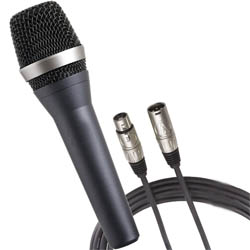
What special considerations should be given to shielding low-impedance cables?
Low-impedance microphone cables are shielded using the same basic methods as coaxial-type instrument cables.
Woven copper braid generally offers the best high-frequency shielding performance and protection from radio-frequency interference (RFI).
This is due to the very high electrical conductivity of the braid, and to its low-inductance, self-shorting configuration. Its disadvantages are primarily economic; it is the most expensive to manufacture and the hardest to terminate.
Spiral-wrapped copper serve shields are very inductive in nature, as they resemble a long coil of wire when extended. This can compromise high-frequency shielding and is not recommended when effective shielding above 100 kHz is required. Serve shields are relatively inexpensive and easy to terminate, making them a popular choice for medium-quality cables.
Foil-shielded cable is very heavily used for permanent installation work and for portable multipair “snake” cables. The extremely low cost, light weight and slim profile makes foil very advantageous in applications involving pulling cable into conduit.
In these cases the conduit (if metallic and properly grounded) can greatly enhance the RFI and EMI shielding properties of the thin mylar/aluminum foil generally used. The 100 percent coverage of the foil shield, which should be of great benefit at radio frequencies, is somewhat compromised by the inductive nature of the copper drain wire typically used for terminating it.
At low frequencies, performance is hampered by the relatively low conductivity of the foil/drain configuration. In applications involving repeated flexing and coiling, the metallized mylar tape will begin to lose its aluminum particles, opening up gaps in the shielding. This can be a particular problem with multipair cable used for touring systems, where the shield breakdown may lead to increased crosstalk between channels and to annoying radio pickup problems.
Does the use of 48-volt phantom power affect the performance of the shield?
The current typically drawn by a phantom-powered condensor microphone is generally limited by 6.81 kohm resistors, resulting in a current of less than 15 mA total.
This is not a significant factor unless the shield begins to break down mechanically due to use: tearing or fraying are possible, which could create intermittant changes in shield resistance. It has lead a few professionals to prefer the use of three-conductor microphone cables, with the common carried by a drain wire in addition to the shield.
BIBLIOGRAPHY
• Ballou, Greg, ed., Handbook for Sound Engineers: The New Audio Cyclopedia, Howard W. Sams and Co., Indianapolis, 1987.
• Cable Shield Performance and Selection Guide, Belden Electronic Wire and Cable, 1983.
• Colloms, Martin, “Crystals: Linear and Large,” Hi-Fi News and Record Review, November 1984.
• Cooke, Nelson M. and Herbert F. R. Adams, Basic Mathematics for Electronics, McGraw-Hill, Inc., New York, 1970.
• Davis, Gary and Ralph Jones, Sound Reinforcement Handbook, Hal Leonard Publishing Corp., Milwaukee, 1970.
• Electronic Wire and Cable Catalog E-100, American Insulated Wire Corp., 1984.
• Fause, Ken, “Shielding, Grounding and Safety,” Recording Engineer/Producer, circa 1980.
• Ford, Hugh, “Audio Cables,” Studio Sound, Novemer 1980.
• Guide to Wire and Cable Construction, American Insulated Wire Corp., 1981.
• Grundy, Albert, “Grounding and Shielding Revisited,” dB, October 1980.
• Jung, Walt and Dick Marsh, “Pooge-2: A Mod Symphony for Your Hafler DH200 or Other Power Amplifiers,” The Audio Amateur, 4/1981.
• Maynard, Harry, “Speaker Cables,” Radio-Electronics, December 1978,
• Miller, Paul, “Audio Cable: The Neglected Component,” dB, December 1978.
• Morgen, Bruce, “Shield The Cable!,” Electronic Procucts, August 15, 1983.
• Morrison, Ralph, Grounding and Shielding Techniques in Instrumentation, John Wiley and Sons, New York, 1977.
• Ott, Henry W., Noise Reduciton in Electronic Systems, John Wiley and Sons, New York, 1976.
• Ruck, Bill, “Current Thoughts on Wire,” The Audio Amateur, 4/82.
This article contributed by Pro Co Sound.
